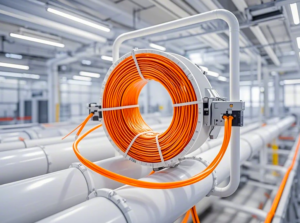目录
ToggleFiber optic cables are advanced transmission mediums that enable the rapid transfer of data over long distances with minimal loss. Unlike traditional copper cables, fiber optic cables use light pulses to carry information, offering unmatched speed, reliability, and security. To understand their significance in modern communication, it’s essential to explore the different types of fiber optic cables, their features, and how they cater to specific applications.

1. Single-Mode vs. Multi-Mode Fiber Optic Cables
The primary classification of fiber optic cables is based on the light propagation mode:
- Single-Mode Fiber Optic Cables: These cables have a small core, around 8-10 microns in diameter, allowing only one light mode to travel through. This streamlined path minimizes light refraction, enabling data to travel longer distances without degradation. Single-mode cables are often used in long-distance and high-speed applications, such as telecommunications and cable television. They support data transmission distances up to 100 kilometers with minimal signal loss, making them ideal for intercity and transoceanic connections.
- Multi-Mode Fiber Optic Cables: With a core diameter of 50-62.5 microns, multi-mode cables allow multiple light modes to travel simultaneously. This design is suited for shorter distances, typically within a few kilometers, as the multiple paths cause signal dispersion, limiting distance capability. Multi-mode fiber optic cables are commonly used in local area networks (LANs), data centers, and enterprise settings, where high-speed data transmission over moderate distances is necessary.
2. Types of Multi-Mode Fiber Optic Cables
Within multi-mode fiber optics, there are additional classifications based on bandwidth and data rate capabilities:
- OM1 (Optical Multi-mode 1): With a core diameter of 62.5 microns, OM1 supports data transmission at speeds up to 1 GB/s over distances of up to 300 meters. It is suitable for legacy systems but has largely been replaced by higher-capacity cables in new installations.
- OM2 (Optical Multi-mode 2): Similar to OM1 but with a 50-micron core, OM2 can reach distances up to 550 meters at 1 GB/s, offering improved performance over OM1.
- OM3 and OM4: These cables are optimized for laser-based transmission, providing higher speeds. OM3 can handle up to 10 GB/s over 300 meters, while OM4 can support the same speed over distances of 550 meters. They are commonly used in high-speed networks and data centers.
3. Armored and Non-Armored Fiber Optic Cables
Depending on the installation environment, fiber optic cables are also available as armored or non-armored:
- Armored Fiber Optic Cables: These cables have a protective layer, often made of steel or aluminum, surrounding the core. This design protects the cables from physical damage, making them suitable for outdoor or industrial applications where they may be exposed to extreme conditions or potential damage. Armored fiber optic cables are preferred for undersea or underground installations.
- Non-armored fiber Optic Cables: These are more common in controlled environments like offices or data centers. Lighter and more flexible, they are easier to install but require additional protection if used outdoors.
4. Indoor and Outdoor Fiber Optic Cables
Another distinction in fiber optic cables is based on their placement and environmental factors:
- Indoor Fiber Optic Cables: These cables are designed for use inside buildings, where they are less exposed to harsh environmental factors. Indoor fiber optic cables are more flexible and easy to handle, facilitating simpler installation within office buildings, hospitals, and educational institutions.
- Outdoor Fiber Optic Cables: Built to withstand environmental challenges such as UV radiation, moisture, and extreme temperatures, these cables are suitable for installation in exposed environments. They are commonly armored and incorporate protective layers to prevent damage and ensure reliable performance over time.
5. Hybrid Fiber Optic Cables
Hybrid fiber optic cables incorporate both power and data transmission capabilities in a single cable. These cables are essential in applications where both power and data need to reach remote devices, such as security cameras or telecommunications towers. Hybrid cables reduce the need for additional power wiring, streamlining installation and reducing costs.
Applications and Advantages of Fiber Optic Cables
Fiber optic cables are crucial in various sectors, including telecommunications, internet, medical, and military applications. Their ability to transmit data at speeds of up to 100 GB/s with minimal signal loss over long distances makes them indispensable in today’s connected world.
- Telecommunications: Fiber-optic cables enable high-speed data transmission over long distances, which is essential for telephone and internet services.
- Medical Field: Fiber optic cables are used in minimally invasive surgeries and imaging, providing high-resolution visuals with precise control.
- Military and Aerospace: Due to their immunity to electromagnetic interference, fiber optic cables are ideal for sensitive military applications and aviation communications.
Fiber optic cables continue to revolutionize communication by offering speed, reliability, and security unmatched by traditional wiring.
0